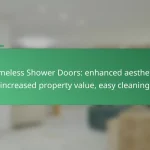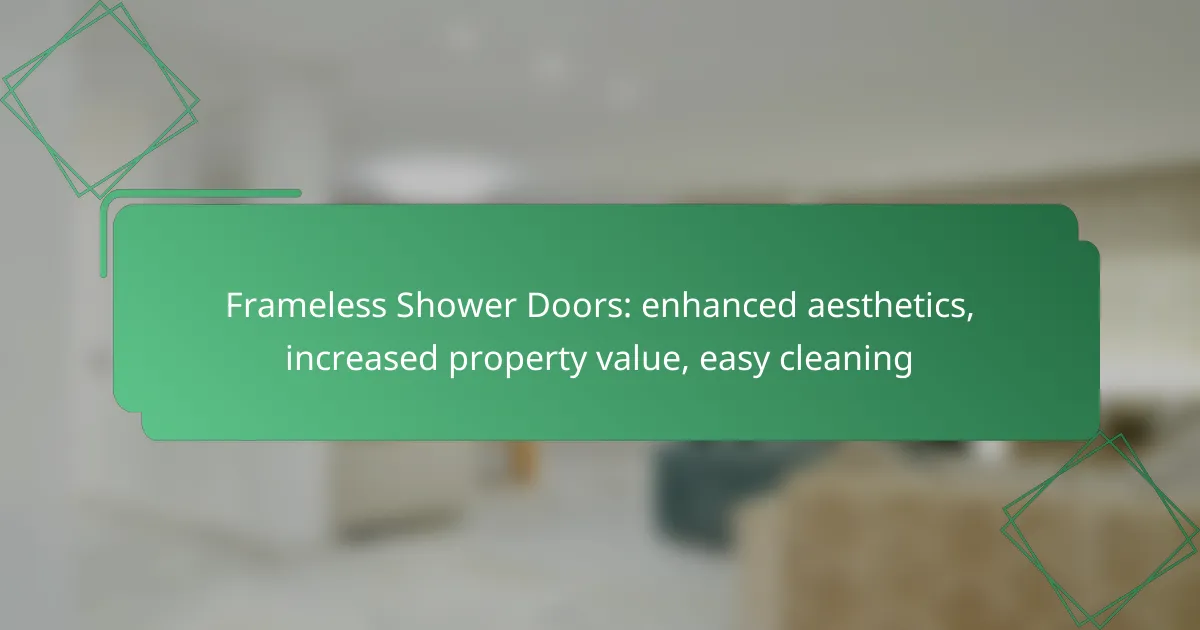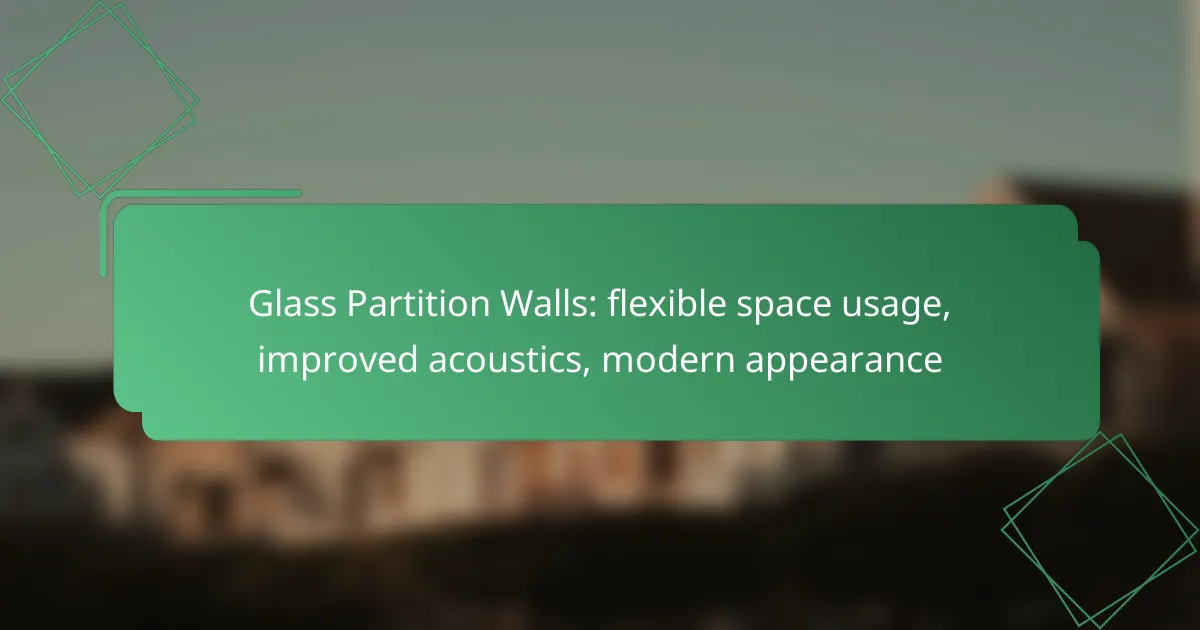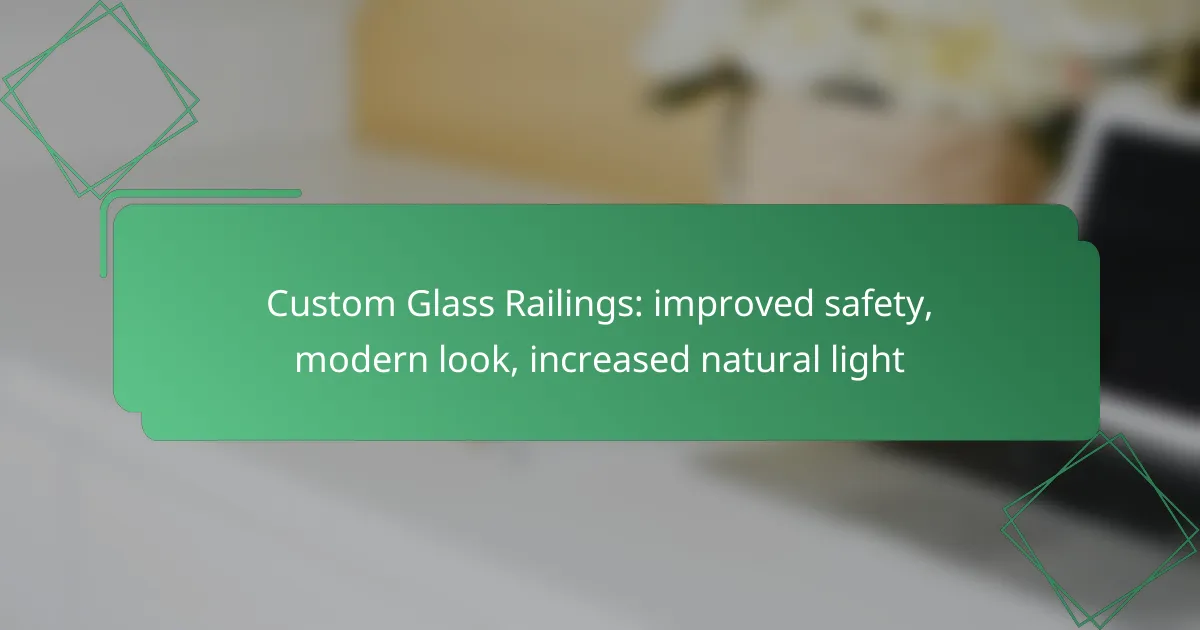Glass canopies serve as an effective solution for weather protection, shielding outdoor spaces from rain, snow, and harmful UV rays. Beyond their practical benefits, they enhance curb appeal with a sleek, modern design that creates an inviting entrance and elevates the aesthetic of any property. Constructed from durable materials like tempered glass and aluminum, these canopies ensure longevity and resilience against the elements.
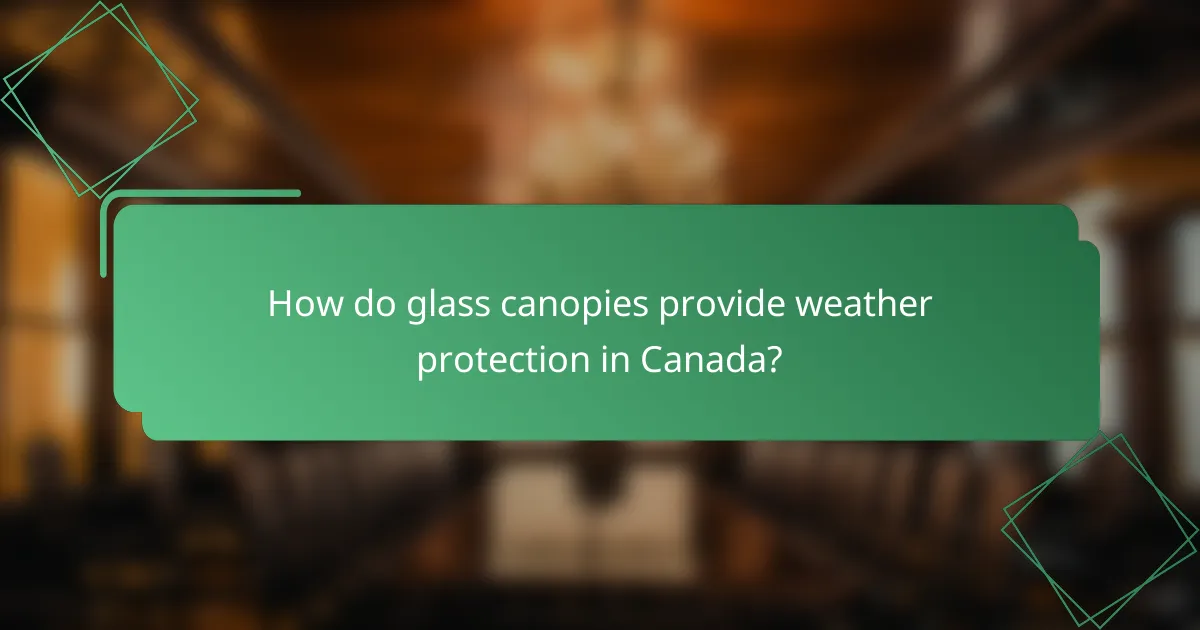
How do glass canopies provide weather protection in Canada?
Glass canopies offer effective weather protection in Canada by shielding outdoor areas from rain, snow, and harsh UV rays. Their durable construction ensures that they withstand the country’s varied climate while enhancing the aesthetic appeal of buildings.
Shield against rain and snow
Glass canopies are designed to deflect rain and snow, keeping entryways and outdoor spaces dry. The sloped design allows precipitation to run off easily, preventing accumulation that could lead to leaks or structural damage.
In regions with heavy snowfall, it’s crucial to select tempered or laminated glass, which can handle the weight of snow without breaking. Regular maintenance, such as clearing snow buildup, will prolong the lifespan of the canopy and maintain its protective function.
UV protection for outdoor spaces
Glass canopies provide essential UV protection, reducing harmful rays that can fade furniture and damage skin. Many glass options come with UV-filtering coatings that enhance this protective feature, making outdoor areas safer and more comfortable.
Choosing glass with a high UV protection rating is advisable, especially in sunny regions. This not only protects occupants but also preserves the integrity of outdoor furnishings, reducing replacement costs over time.
Wind resistance features
Wind resistance is a critical consideration for glass canopies in Canada, where gusty conditions can be common. Many canopies are engineered to withstand high wind loads, ensuring they remain secure during storms.
When selecting a glass canopy, look for models that meet local building codes for wind resistance. Proper installation is also vital; ensure that the canopy is anchored securely to withstand potential wind uplift and lateral forces.

What are the benefits of glass canopies for curb appeal?
Glass canopies significantly enhance curb appeal by providing a sleek, modern look while offering protection from the elements. They create an inviting entrance and can elevate the overall aesthetic of a property, making it more attractive to potential buyers or visitors.
Modern aesthetic enhancement
Glass canopies contribute to a contemporary aesthetic that complements various architectural styles. Their transparency allows natural light to filter through, creating an open and airy feel. This modern design choice can make a property stand out in a neighborhood, appealing to those who appreciate clean lines and minimalism.
Incorporating a glass canopy can also highlight other design elements of a home, such as doorways or landscaping, enhancing the overall visual impact. The use of high-quality materials ensures that the canopy remains visually appealing over time, resisting weather-related wear and tear.
Increased property value
Installing a glass canopy can lead to an increase in property value, as it adds both functionality and style. Homes with attractive entrances are often perceived as more desirable, which can translate into higher resale prices. Potential buyers may be willing to pay a premium for properties that offer unique features like glass canopies.
Moreover, the investment in a glass canopy can yield returns, especially in competitive real estate markets. Properties that stand out due to their aesthetic appeal are more likely to attract interest, potentially reducing the time on the market.
Customizable design options
Glass canopies come with a variety of customizable design options to suit individual preferences and architectural needs. Homeowners can choose from different shapes, sizes, and frame materials, allowing for a tailored fit that enhances the property’s character. Options may include frameless designs for a sleek look or framed versions for added durability.
Additionally, homeowners can select glass types, such as tinted or frosted, to achieve desired levels of privacy and light filtration. This customization ensures that the canopy not only serves its purpose but also aligns with the homeowner’s vision for their property. Working with a professional can help in selecting the best options that meet both aesthetic and functional requirements.
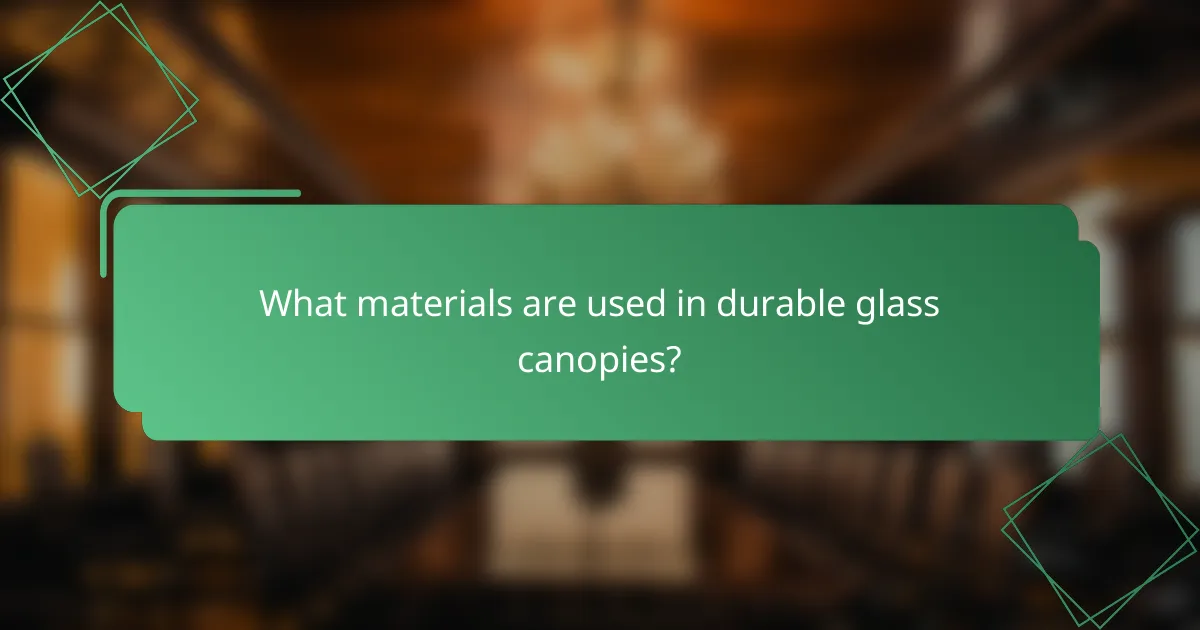
What materials are used in durable glass canopies?
Durable glass canopies are primarily made from tempered glass, aluminum frames, and weather-resistant coatings. These materials work together to provide strength, longevity, and protection against the elements.
Tempered glass for strength
Tempered glass is a type of safety glass that is treated to be much stronger than regular glass. It can withstand high impact and thermal stress, making it ideal for outdoor applications like canopies. This strength reduces the risk of breakage, ensuring safety and longevity.
When selecting tempered glass, look for options that meet safety standards such as ANSI Z97.1 or CPSC 16 CFR 1201. These certifications indicate that the glass has undergone rigorous testing for durability and safety.
Aluminum frames for longevity
Aluminum frames are commonly used in glass canopies due to their lightweight yet robust nature. They resist rust and corrosion, making them suitable for various weather conditions. This durability ensures that the frame will last for many years without significant maintenance.
When choosing aluminum frames, consider options with a powder-coated finish for added protection against the elements. This finish not only enhances the aesthetic appeal but also increases the frame’s resistance to scratches and fading.
Weather-resistant coatings
Weather-resistant coatings are applied to both glass and aluminum components to enhance their durability against rain, snow, and UV rays. These coatings help prevent deterioration and maintain the appearance of the canopy over time. They can also reduce the frequency of cleaning required.
Look for coatings that offer UV protection and are easy to clean. Some products even provide self-cleaning properties, which can save time and effort in maintenance. Regularly inspect the coatings to ensure they remain intact and effective.
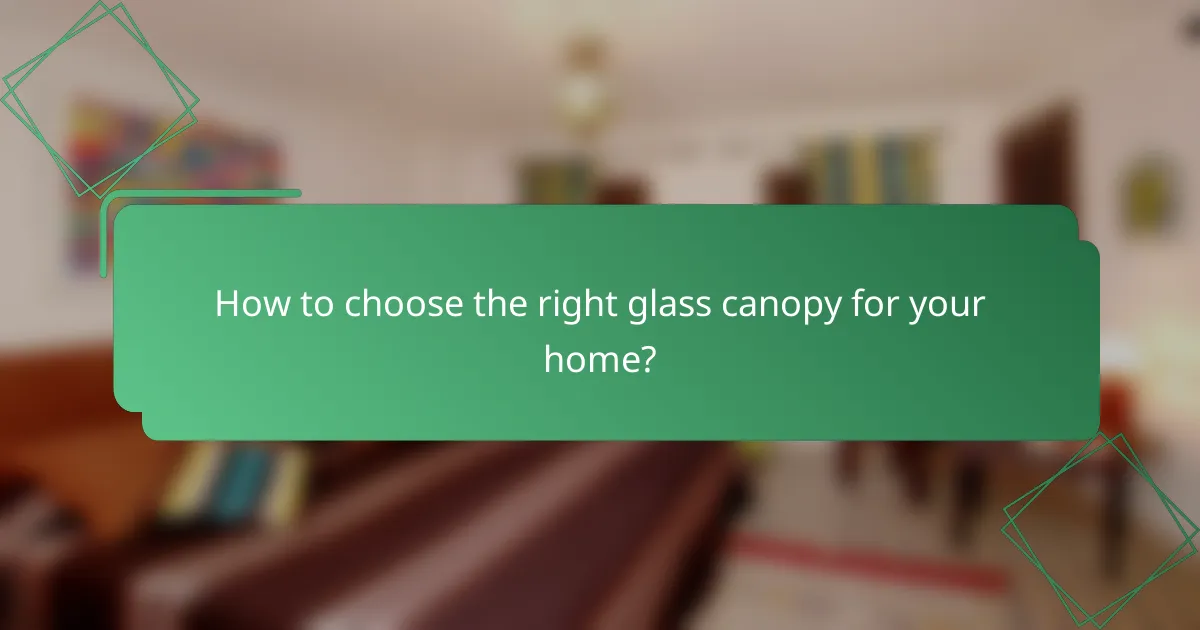
How to choose the right glass canopy for your home?
Choosing the right glass canopy involves considering factors like climate, design compatibility, and installation requirements. These elements ensure that the canopy not only enhances your home’s curb appeal but also provides effective weather protection and durability.
Consider local climate conditions
Your local climate significantly influences the type of glass canopy you should select. For instance, areas with heavy snowfall may require thicker, tempered glass to withstand the weight, while regions with intense sunlight might benefit from UV-resistant coatings.
Additionally, consider wind resistance. If you live in a windy area, look for canopies designed to endure high wind loads, which often feature reinforced frames and secure anchoring systems.
Evaluate design compatibility
The glass canopy should complement your home’s architectural style. For modern homes, sleek, frameless designs may be ideal, while traditional homes might benefit from canopies with ornate frames.
Color and finish also play a role. Choose a canopy that harmonizes with your existing exterior colors and materials to maintain a cohesive look. Consider consulting with a designer for tailored advice.
Assess installation requirements
Installation can vary widely based on the canopy’s size and design. Some canopies may require professional installation, especially those that are larger or more complex, while smaller, simpler models might be suitable for DIY projects.
Check local building codes and regulations, as some areas may have specific requirements for glass structures. Ensure you have the necessary permits before proceeding with installation to avoid potential fines or complications.
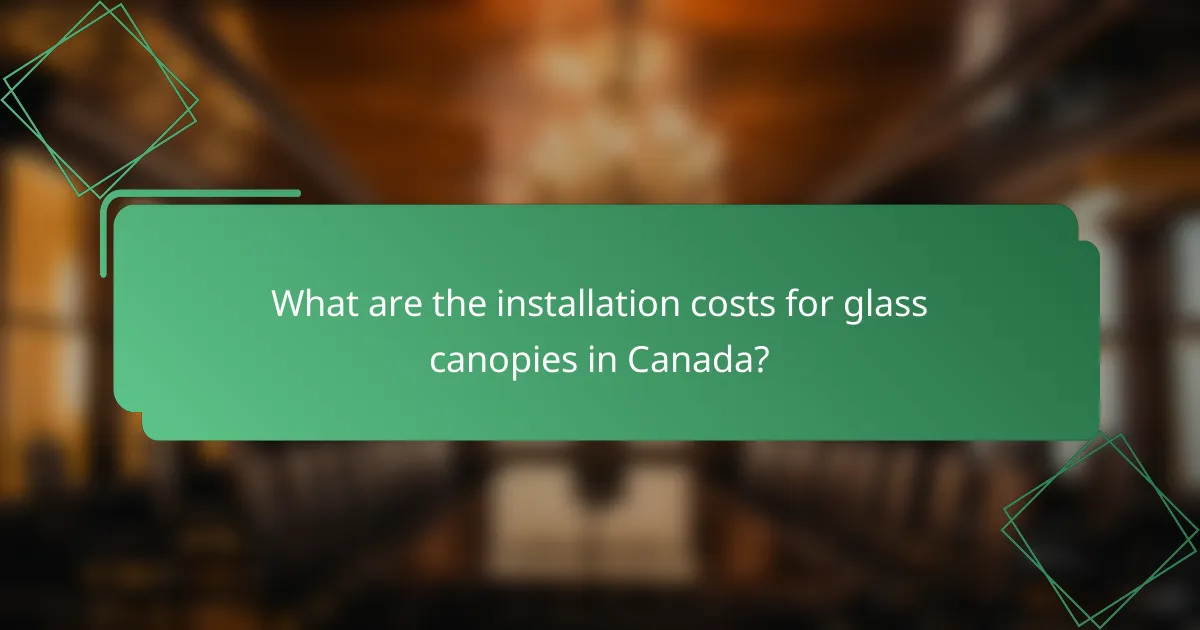
What are the installation costs for glass canopies in Canada?
The installation costs for glass canopies in Canada typically range from CAD 1,500 to CAD 5,000, depending on various factors such as size, design, and installation complexity. Homeowners should consider these costs when planning for weather protection and enhanced curb appeal.
Average pricing ranges
The average cost for a standard glass canopy installation can vary significantly. Basic models may start around CAD 1,500, while more elaborate designs with custom features can exceed CAD 5,000. On average, most homeowners can expect to pay between CAD 2,500 and CAD 4,000 for a quality installation.
Factors affecting installation costs
Labor costs can vary by region and contractor experience, which may add to the total expense. It’s advisable to obtain multiple quotes to ensure competitive pricing and quality service.
Financing options available
Homeowners looking to finance their glass canopy installation have several options. Many contractors offer payment plans or financing through third-party lenders, allowing for manageable monthly payments. It’s essential to review the terms and interest rates associated with these financing options.
Additionally, some local governments may provide grants or incentives for home improvements that enhance energy efficiency or curb appeal. Researching these opportunities can help offset installation costs.
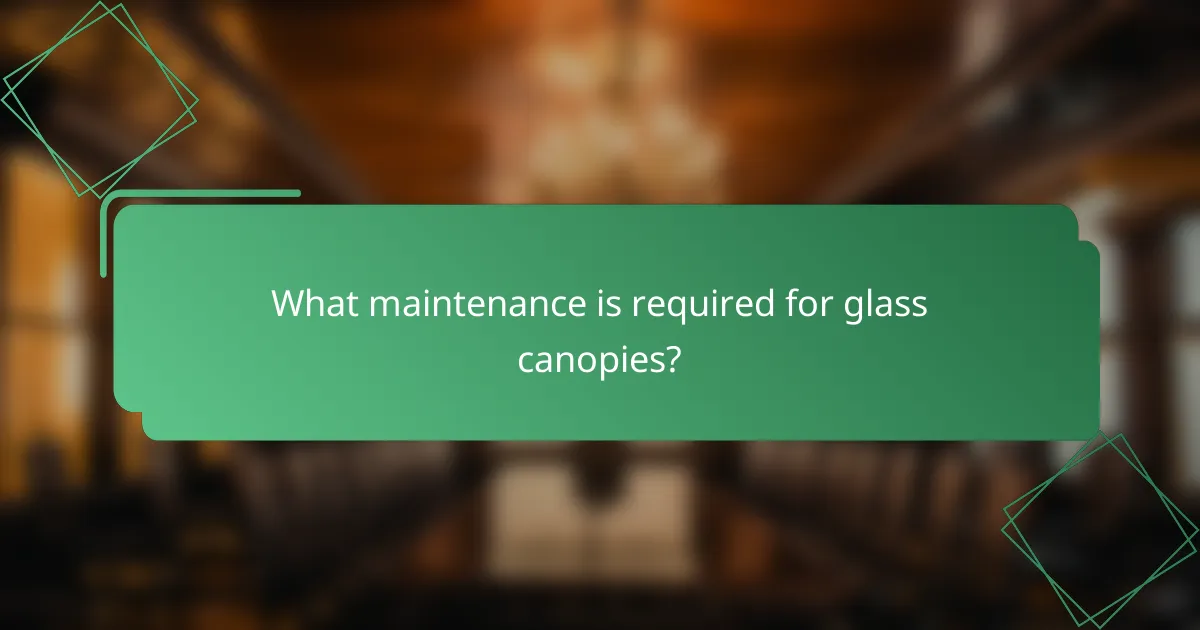
What maintenance is required for glass canopies?
Glass canopies require minimal maintenance to ensure they remain functional and visually appealing. Regular cleaning and periodic inspections are essential to maintain their condition and longevity.
Cleaning glass canopies
Cleaning glass canopies should be done at least twice a year to remove dirt, debris, and any potential stains. Use a soft cloth or sponge with a mild detergent solution to avoid scratching the glass surface. For stubborn spots, a glass cleaner can be effective.
Avoid using abrasive materials or harsh chemicals, as these can damage the glass or the frame. In regions with heavy rainfall or dust, more frequent cleaning may be necessary to maintain clarity.
Inspecting for damage
Regular inspections of glass canopies are crucial for identifying any signs of wear or damage. Check for cracks, chips, or loose fittings that could compromise the structure’s integrity. It’s advisable to conduct these inspections at least once a year, or after severe weather events.
If any damage is found, it’s important to address it promptly to prevent further issues. Consult a professional for repairs, especially if the damage affects the canopy’s support structure.
Maintaining the frame and supports
The frame and supporting structures of glass canopies also require attention. Inspect metal or wooden frames for rust, rot, or corrosion, and treat them accordingly. Applying a protective sealant or paint can extend the life of the frame.
Ensure that all fittings and fasteners are secure, as loose components can lead to instability. Tightening or replacing these parts as needed will help maintain the canopy’s safety and functionality.




